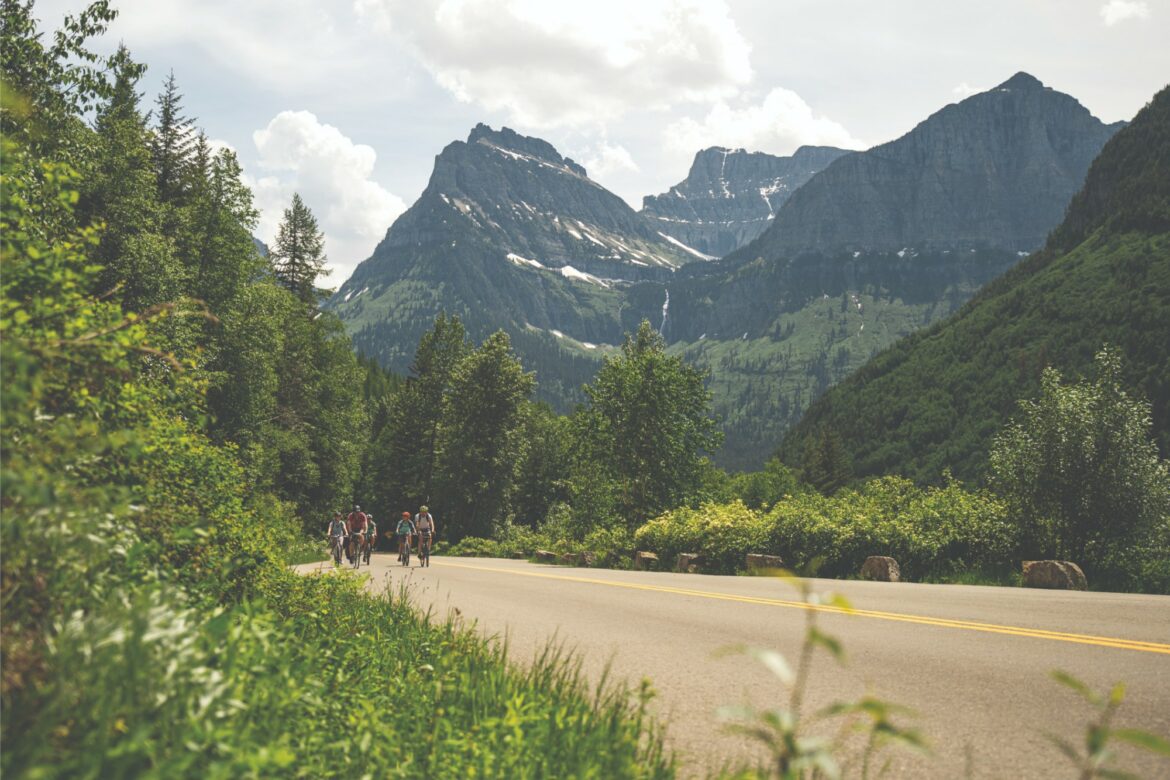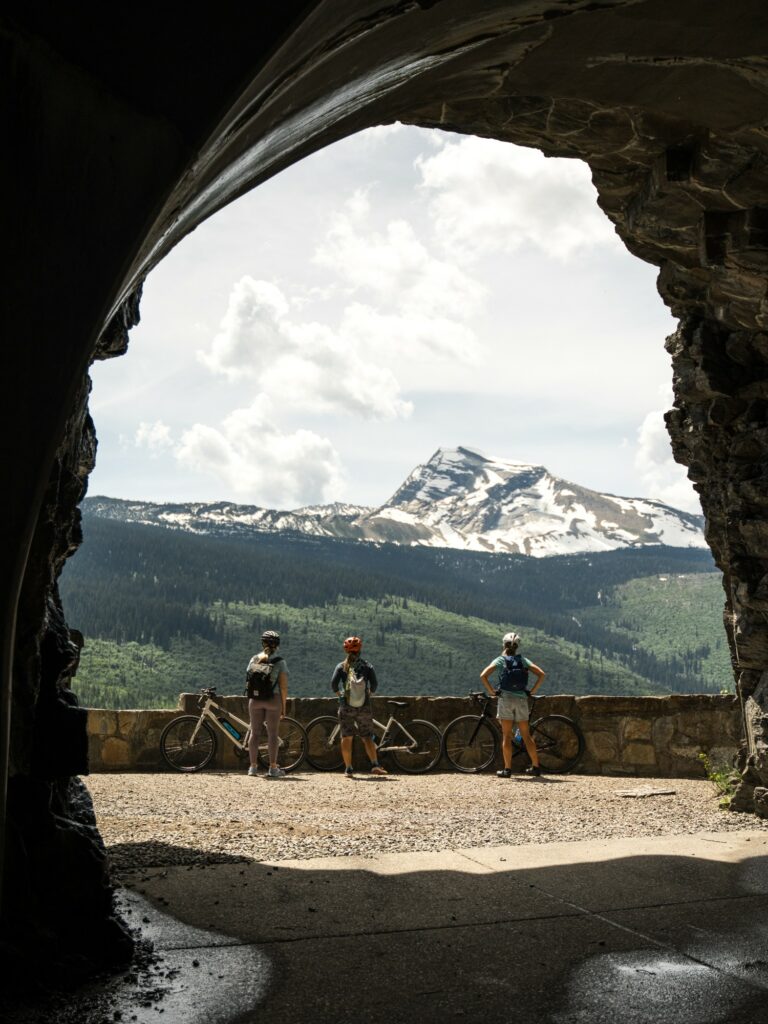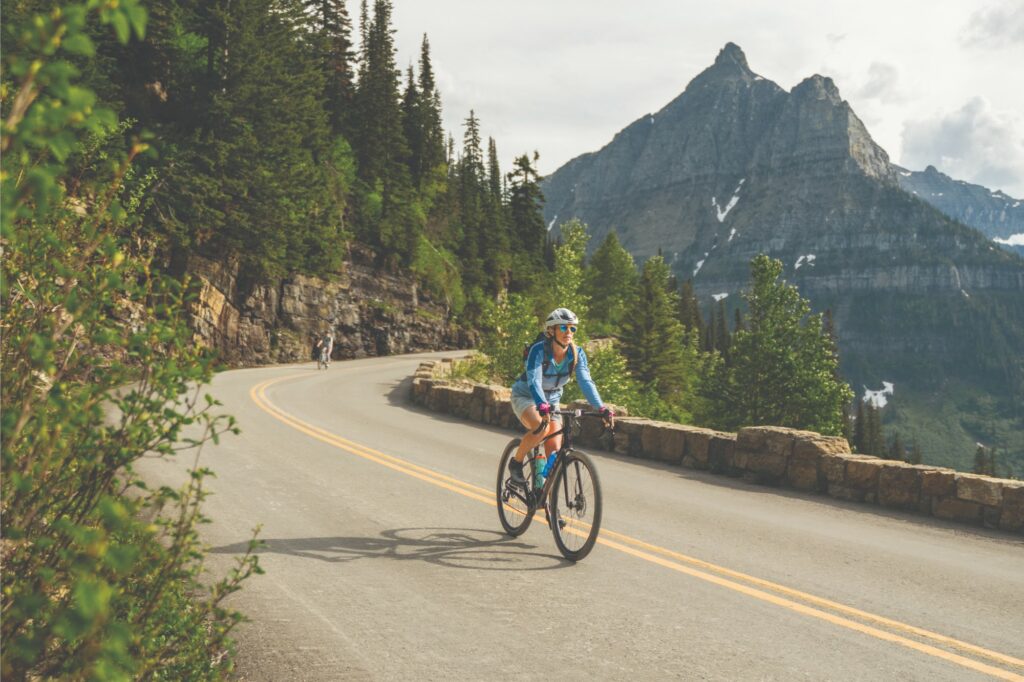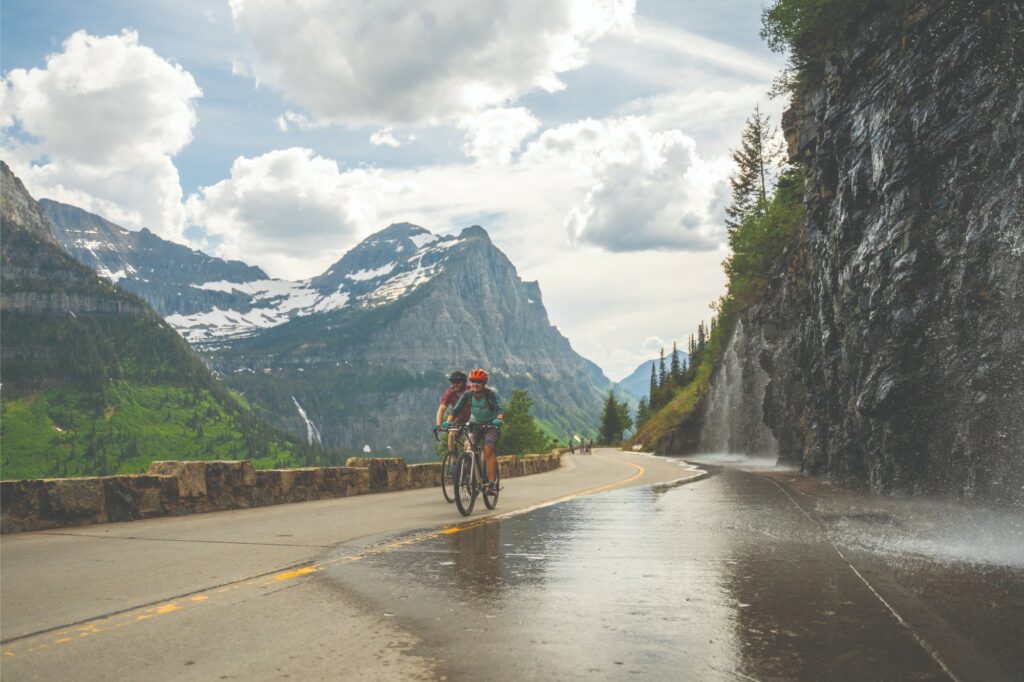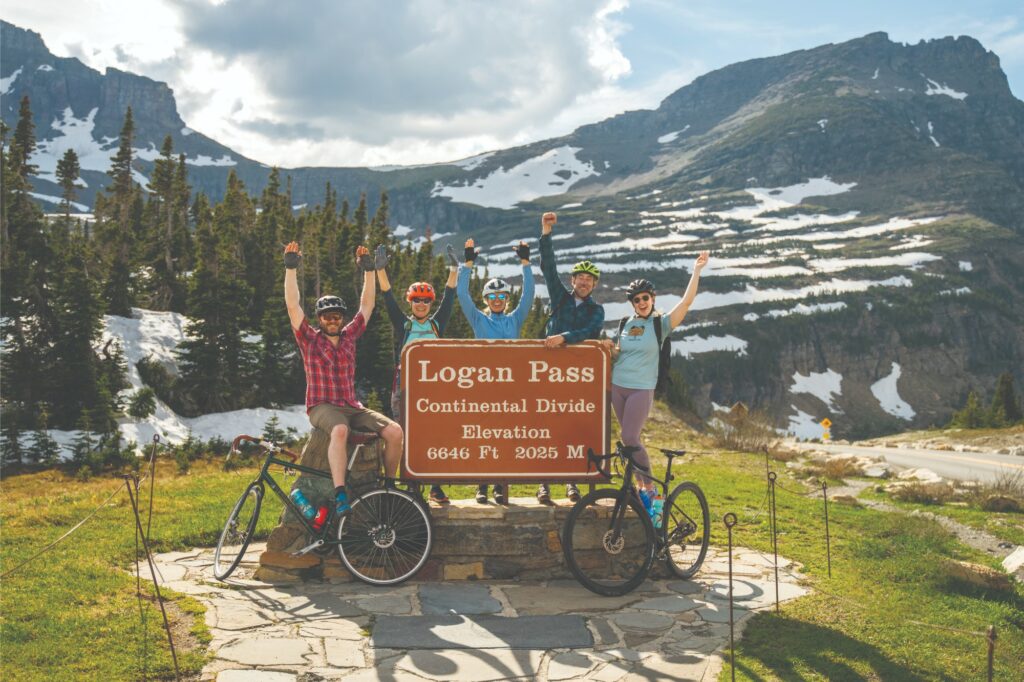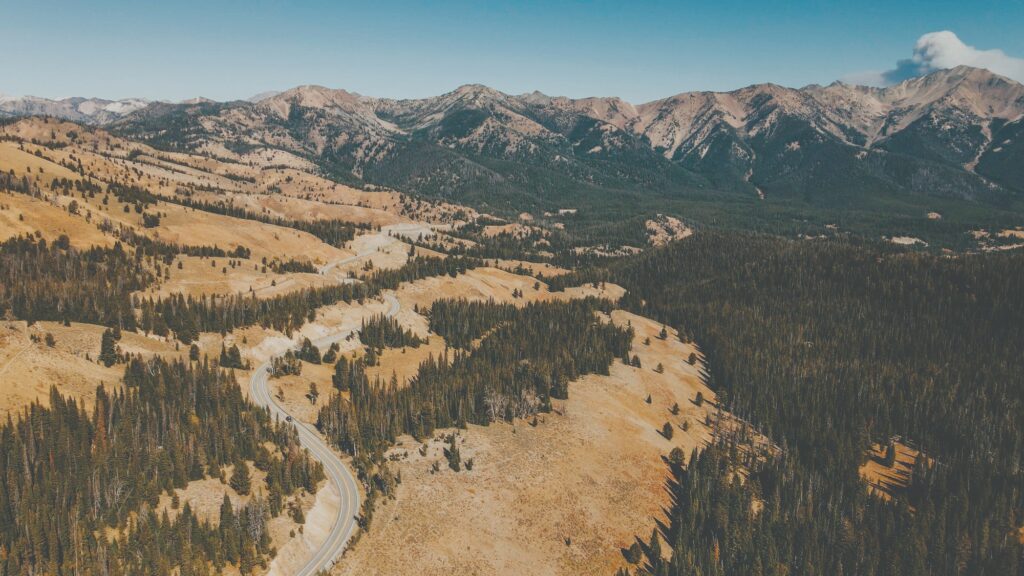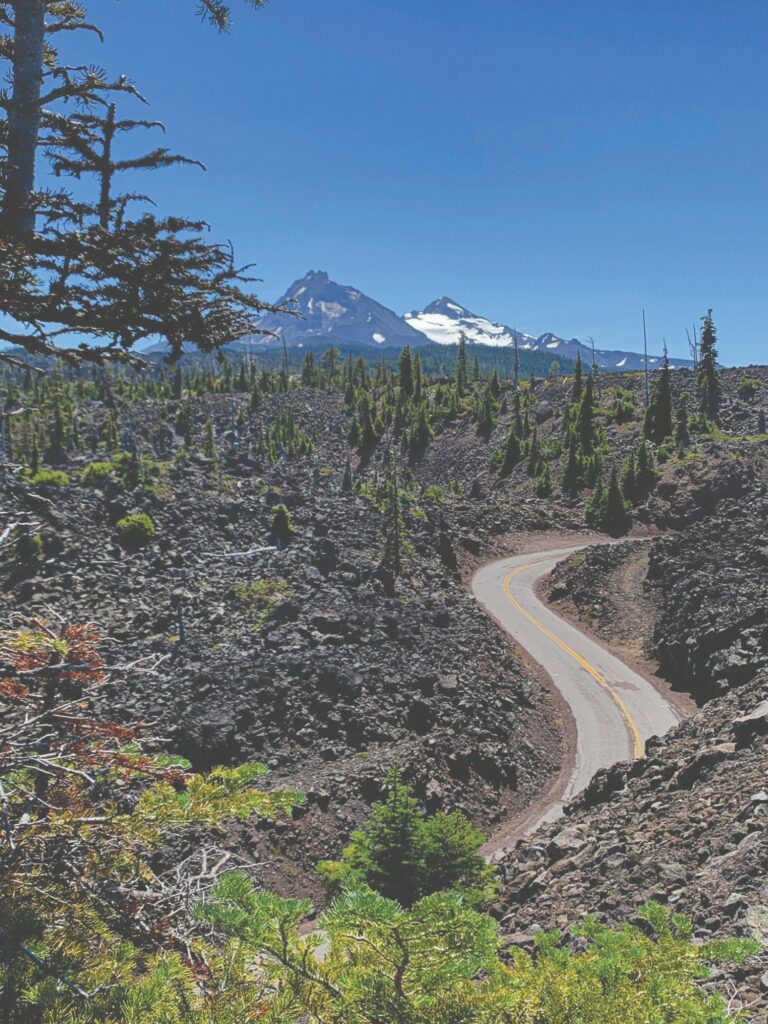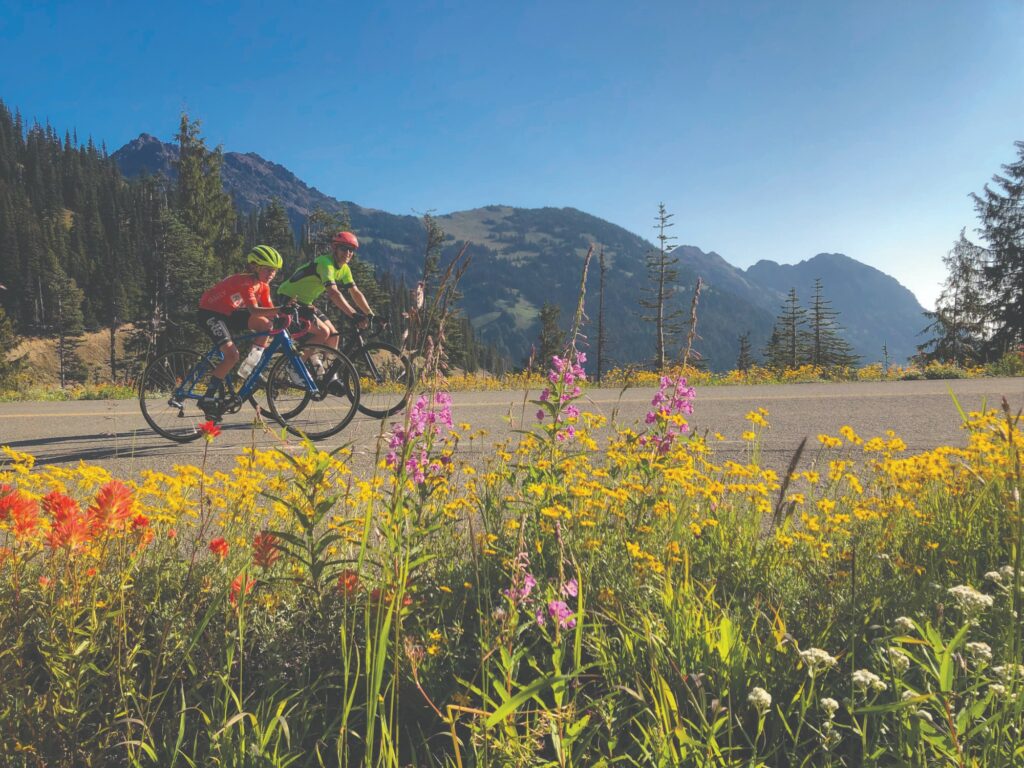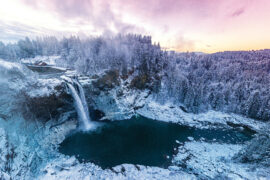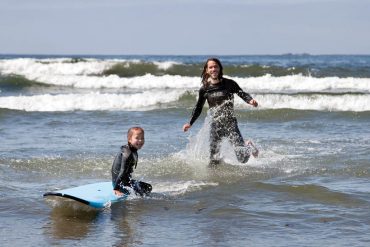By road bike or e-bike, Glacier’s Going-to-the-Sun is a top American journey through time + elevation
written by Kevin Max
photography by Whitney Whitehouse
Some people have heard about the Going-to-the-Sun Road and make plans to cycle it and train for months to be fit enough to gain the sustained vertical feet
to the top. Others have listened to their most athletic (and somewhat nauseating) friends recall with laughter the 3,200-foot climb to the top of Logan Pass. “I was pushing 275 watts at the summit, man!” Still others may completely tune out one of Glacier National Park’s most spectacular experiences because it’s simply beyond their physical limit.
On a spring morning last year, I joined a group of riders who fit into each one of these profiles on a push for this Glacier experience. Half of us were on bicycles—road bikes—the other half were on e-bikes. Our hybrid crew could not have been more inclusive and fun. Let’s face it, homogenous culture is but a mirror that gets you no further in life than your own reflection. Road bikers can quickly become inbred as thoroughly as e-bikers can. In a way, the combination of these cultures is perfect for when this epic pass opens to non-motorized traffic in spring. When snow is still being cleared, there are upper portions of Going-to-the-Sun Road open to bikers and closed to automobiles. (Keep your eye on the Glacier National Park website.) If you can thread that needle, this is your clean-air, wildly scenic, wildlife-encountering spring release. This also recounts my experience.
First, a brief note on e-bikes. It wasn’t until right around the year 2000 when e-bikes started showing up on roads out west. True road bikers were aghast, mountain bikers were chaffed and e-bikers were living their best lives. These were the early days, and no one trusted anyone.
Today, the technology of e-bikes has become sophisticated, quiet and sustained, bringing access to experiences like this to people who would normally be left back at the bakery, missing the opportunity to become another advocate for the outdoors.
Going-to-the-Sun Road, 25 miles east of Whitefish, Montana, appears as a vertical challenge, a rite of passage, a scenic tour that winds up to Logan Pass at 6,646 feet. A drop of rain that fell on the east side of Logan Pass would flow toward the Atlantic Ocean. A drop that fell a few inches over on the west side would end up thousands of miles away in the Pacific.
Going-to-the-Sun Road is 50 miles long and the only paved road to traverse the width of Glacier. For us, this ride would begin at Apgar Campground just inside the West Glacier entrance and climb approximately 29 miles to the apex at Logan Pass. A good rule of thumb is seven hours from parking lot to peak and back. The weather for riding could not have been better—cool morning for the climb and warmer afternoon for the descent.
To set yourself up for success, begin your day early at Markus Community Market in Whitefish. You’ll find breakfast burritos, bagels and coffee to get your morning started. Plan for a mid-ride lunch and a summit snack. There are gourmet wraps, chips and chocolate to pack for the ride. Fill your water bottles and shove off for Apgar Campground. Note that you’ll need passes for the park, which you should obtain in advance as their daily numbers are limited.
Think of your clothing as cyclical. You’ll want to begin in something that keeps you warm enough as you begin to slowly warm up along the first stretch that borders Lake McDonald. Beyond McDonald, the pitch of the road increases and your internal temperature with it, if you’re on a road bike. Those on e-bikes should also dress in layers and for comfort. Mountain temperatures are almost always cooler than the weather readings in the lower towns.
As you emerge from the riverine canopy, you’ll begin to understand why this ride is one of the most beautiful muses for those on two wheels out under Montana blue skies and among the snowy peaks of the Rockies. It’s a sporting and gorgeous 12 miles past Lake McDonald to The Loop, miraculously the only switchback along the mountain road.
In 1918, National Park Service engineer George Goodwin drew the plans for the daring feat that would become Going-to-the-Sun Road. Ultimately, his plan had too many switchbacks to become the mellifluous beauty that others had envisioned. Thomas Vint, a National Park Service landscape architect, had a different vision that called for sweeping lengths and just one switchback up to Logan Pass. The Park Service engaged Frank Kittredge of the Bureau of Public Roads to lead the Herculean effort to build the newly designed road with only one switchback. Kittredge began in 1924.
A vision of a national treasure was already underway, as Congress had begun providing annual funds for the road’s construction in the early 1920s. Kittredge and his crew of thirty-two men climbed on foot 3,000 feet some mornings to reach the road survey sites. In the first three months, Kittredge
saw men abandon at a 300 percent
rate, according to one National Park Service history.
The Loop switchback has facilities and a parking lot, and it’s where we stopped for lunch before the last steeper push to the top. It wasn’t long into the final leg that a four-legged creature ambled out of the roadside underbrush. A young black bear seemed more interested in his own life pursuits than stopping to mingle with any of us.
Farther up the road, you can’t miss Bird Woman Falls, a 500-foot cascading waterfall in the saddle between Mount Oberlin and Mount Cannon. One of Glacier’s biggest falls, Bird Woman will remind you to take a moment to drink your own water as you continue your climb.
There is no shortage of water on this road. Farther on, cool meltwater pours broadly and gently out of a rock wall on the left side of the road. Weeping Wall is a geological formation that might otherwise be confused with a man-made contrivance put there for overheated cyclists as they approach the summit. Best practice here is to dismount and walk under the falling water and the slick surface underfoot.
Logan Pass arrives on a breeze and sense of accomplishment. From the parking lot, it’s not difficult to spy mountain goats lolling on the distant mountainside. Their ancestors from the 1930s would have been astounded enough to stop the ruminants mid-grass as music floated across the mountain meadows to where they stood.
In 1933, Going-to-the-Sun Road opened to a chorus of Civilian Conservation Corps members and the Blackfeet Tribal Band who played The Star Spangled Banner for nearly 4,000 people atop Logan Pass. There is natural memory in the surrounding granite, in some musical DNA micro-mutations of the resident mountain goats and in the breeze that conducts its own woodwind sonata.
Take time to celebrate the victories, the beauty, the small things, the natural, and one of the finest journeys for either bike or e-bike tribes.
After the Conservation Corps chorus and Blackfeet Tribe played The Star Spangled Banner, it was followed by a ceremony of peace between the Blackfeet, Flathead and Kootenai tribes. A photo from the Montana Historical Society from that time shows Blackfeet Indians in tribal dress, some on horseback, and mingling with white people outside of a line of impressive tipis.
Not all celebrations will feel exactly the same, but they will resonate and tingle as you begin your descent from Logan Pass to the baptism waters of Weeping Wall, past Bird Woman Falls to The Loop’s single switchback, the canopy along Lake McDonald and taking the form of a furtive smile as you drive back to Whitefish, where good food and drink taste even better in the cool mountain nights.
Other Spectacular Bike + E-bike Journeys
Galena Summit
Smiley Creek Lodge to Galena
Lodge out and back // Idaho
This adventure begins at Smiley Creek Lodge just north and over Galena Summit, climbing almost 2,000 feet in the first 4 miles before a long scenic descent to Galena amid the Boulder Mountains. Galena Lodge has a great cafe for lunch and drinks before making the return trip.
McKenzie Highway
Sisters // Oregon
One of the true rites of passage in Central Oregon is riding the McKenzie Pass just after the snow is cleared and before automobile traffic is permitted. This takes place usually in May and until the gate is opened for cars the third week of June. Those who take on this scenic byway aspire to ride from Sisters to McKenzie Bridge and back in a massive 76-mile effort with 4,000 feet of climbing. Sisters is a perfect fueling station in the morning at Sisters Bakery or Angeline’s Bakery, and cross the finish line at Three Creeks Brewing.
Hurricane Ridge
Olympic Peninsula // Washington
A challenging and wonderfully scenic route, Hurricane Ridge in Olympic National Park begins in Port Angeles and climbs through old-growth forest for 18 miles and 5,242 feet up to Hurricane Ridge and sweeping views of the Strait of Juan de Fuca. At nearly a mile above sea level, Hurricane Ridge also offers panoramic views of the Bailey Range of the Olympic Mountains. The day lodge burned to the ground in May 2023, but Washington Sen. Patty Murray had secured $80 million for its rebuild by October of the same year. Plan to self support during this ride.


